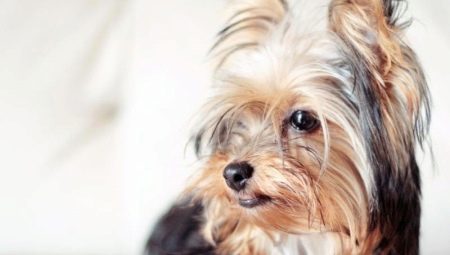The Yorkshire Terrier does not need a special introduction - this is one of the most popular dogs in the world, and among the decorative breeds, perhaps even the most popular. Despite the fact that such dogs are bred everywhere and are in the top of the most recognizable breeds, even the owners can not always answer all questions regarding their pets. If you are just thinking of having such a beast, you should first understand what it is and how to properly care for it.
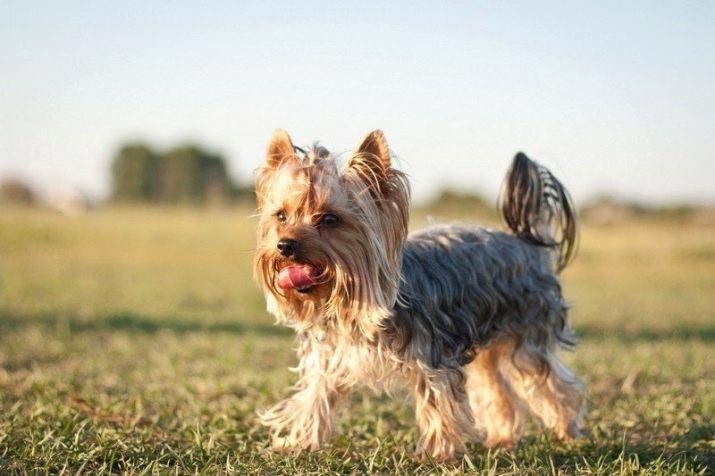
Origin history
Despite the exquisite attractiveness of such a dog, the Yorkshireman has a very indirect relation to ancient times and beautiful ladies - he appeared relatively late. Moreover, many researchers are inclined to believe that York has a "proletarian" origin: its main ancestor is supposedly the Waterside Terrier - a typical peasant dog that should have been content to bark, scare and chase rodents loudly, but not enough to cause significant damage to the fields of noble people.
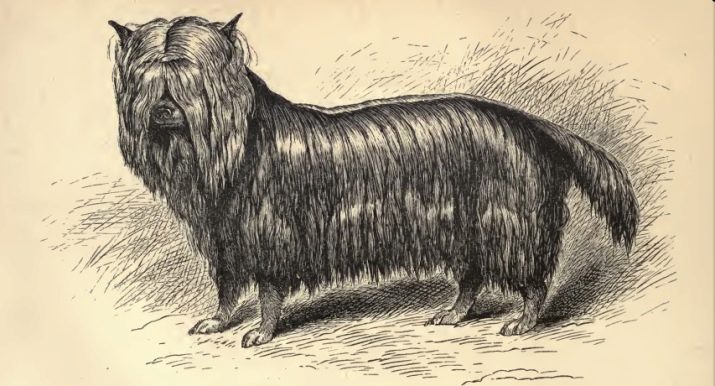
Waterside was in demand in the 18th-19th centuries on the territory of the county of Yorkshire, in northern England - there, and in neighboring Lancashire, the ancestors of everyone's favorite breed appeared. There is a version that another breed, popular for several centuries, Maltese (Maltese lap-dog), took part in the formation of the modern look of the Yorkshire.
It is difficult to say how true this is, however, it is proved that lighter Yorkies, who are close in color to a likely ancestor, have an increased quality of wool, which the Maltese have always been famous for.
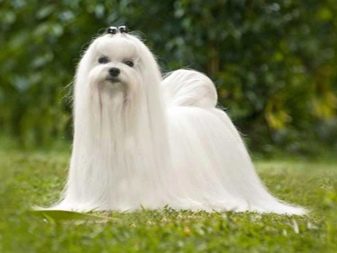
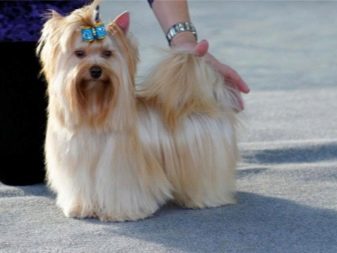
It is believed that industrialization, which took place from the second half of the 18th century, also played a role in breeding Yorkshire terriers. Then workers from neighboring Scotland began to arrive in Yorkshire en masse, and with them - varieties of the Scottish Terrier. Some of these varieties have never been recognized as a separate breed and have been lost to date, however, they are credited with a certain part in the breeding of modern Yorkshire.
The last probable ancestor of the breed in question is the Manchester Terrier. At first, it was not remarkable for anything, however, over time, breeders managed to get individuals with increased softness and silkiness of longer hair. In this form, Manchesters could also take part in the creation of a new, especially attractive hybrid.


In those days, many weaving factories were opened in Yorkshire, and it was their employees, who knew very well what ideal wool could be, were engaged in breeding the future new breed. Initially, the doggie had a long silky coat of a somewhat unusual color for our time - it had a bluish-steel hue and varied with golden brown tan marks.

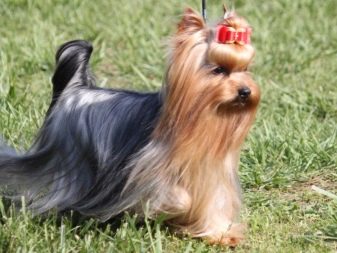
Those dogs were slightly longer and larger than the current ones - 6-7 kilograms were considered their normal weight. The new breed turned out to be so much better than the existing ones that in several decades it ousted its ancestors or colleagues from the homes of the British. In 1886, the Kennel Club, a leading British cynological organization, officially recognized Yorkshire as a new breed of dog, and in 1898 the first club was founded.
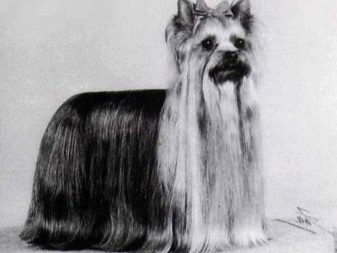
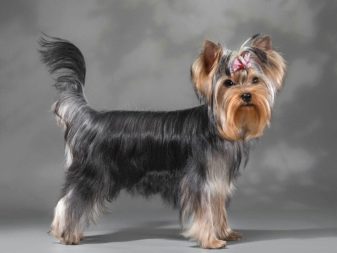
Curious that these dogs went abroad quite early, and already in 1878 the American Kennel Club recognized this breed - earlier than at home. Although in the second half of the century before last, new dogs were extremely popular, the first half of the last century became a period of calm for them. They were hardly mentioned by the media, and in the same England the studbook was annually updated with only 250 new individuals.
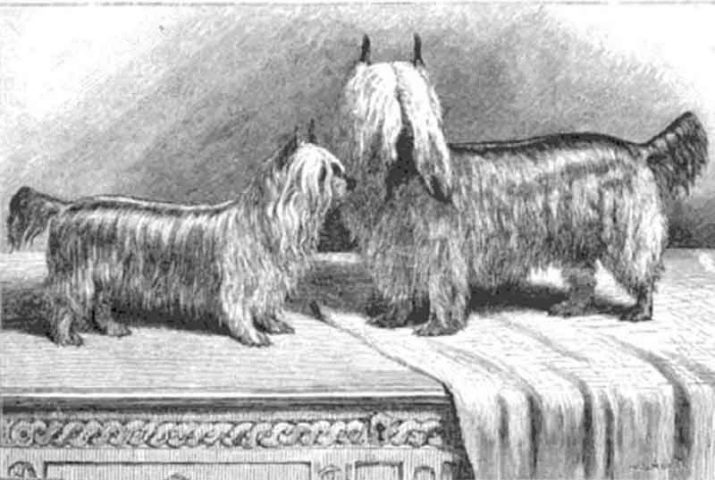
After the Second World War, popularity began to revive - in the same country in 1949 there were already about a thousand new thoroughbred doggies, and in 1960 - more than 4 thousand. In the same period, the rise began in the States, and by the mid-2000s, Yorkshire was the second most popular breed of the country, quantitatively second only to Labradors. Yorks appeared in Russia quite late - it is believed that the first copy was imported in 1971 and belonged to the ballerina Olga Lepeshinsky.
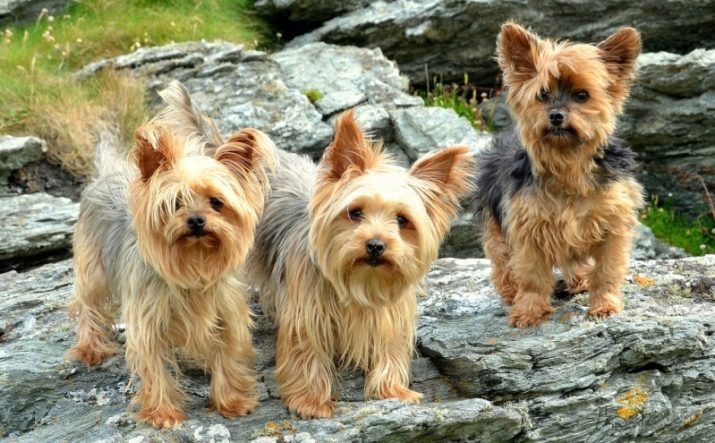
Before the collapse of the USSR, only a few specimens of Yorkshire people were present in the country, only in large cities. The first nursery in the country was founded in 1991 in Mytishchi near Moscow - immigrants first settled here from Spain and England, and a little later - from France. To date, approximately 75 nurseries are officially registered in Russia, however, only one in five is located outside of Moscow and the Moscow Region.
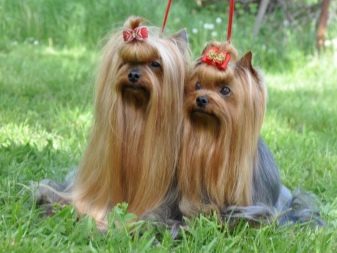
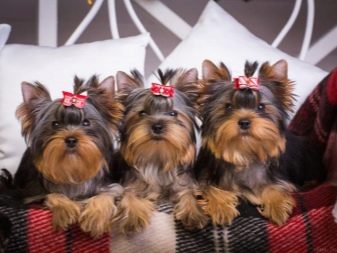
Description of appearance
According to the standard, the Yorkshire Terrier breed is one of the smallest in the world - the maximum weight of an adult can not exceed 3.2 kilograms, but the smallest height or weight is not indicated at all. The official specification prescribes wool of long length, strictly straight and falling down in uniform strands. The parting extends along the entire length of the body, from the tip of the nose to the tip of the tail. Despite its modest size, the dog looks very aristocratic - this is facilitated by a proud and confident posture.
Unlike many other dogs, Yorkshire is deprived of an undercoat. This means that, on the one hand, they do not fade, on the other hand, they freeze quite easily in cool weather.The york coat is often compared with human hair - in the sense that it grows continuously, and individual hairs fall out mainly with intense exposure to them.
Representatives of this breed are also highly valued for the fact that the absence of hair falling out minimizes the risk of an allergic reaction in a person.
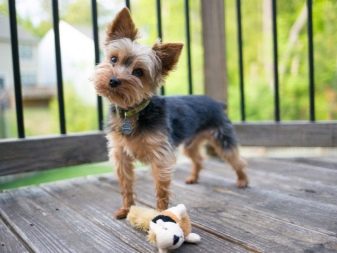
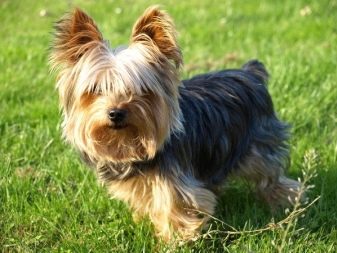
Regardless of whether it is a boy or a girl, the dog is decorated with beautiful red-brown wool of a special golden hue growing on the head - even individual gray or black hairs are not allowed here. This color does not extend to the neck anymore - from the cervical tubercle to the beginning of the tail, the standard is considered to be a deep bluish-steel tone, which in most cases does not strike the eye, because the dog in this place is traditionally trimmed quite shortly. Here, on the contrary, blotches of such colors as bronze, tan and any other dark will be completely superfluous.
The limbs are characterized by the same color as the muzzle, but here at the roots the hairs are darker, and as they move away from the body, their ends lighten. Such a color is allowed only in that part of the limbs that is located below the knees, above the bluish-steel coat, as on the body. The cover is of the same shade on the tail, and here it stands out with greater darkness, intensifying towards the end.
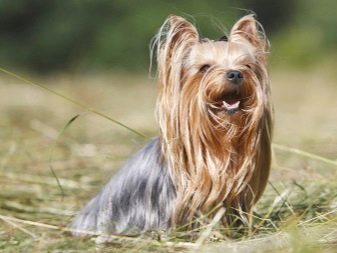
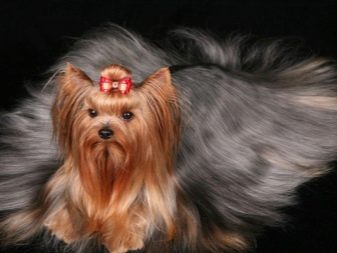
Character Features
The Yorkshire Terrier is not so much a pet as a new member of the family, as he considers himself to be the owner of the house. Such a beast, despite its modest size, He is distinguished by increased cheerfulness, he loves to rush there and back, has endurance and an excellent reaction. At the same time, the dog loves its owners very much and is ready for everything for them - in particular, it has a desperate courage to protect its people and home even in the face of a noticeably superior enemy.
The small size of the brain does not prevent the Yorkshire from being quite intelligent creatures - they are well trained and able to learn many different teams.

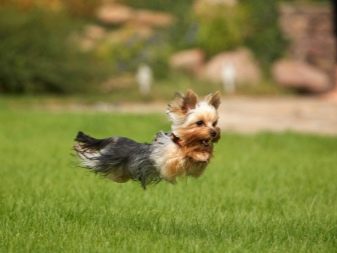
Already one gait of representatives of this breed says a lot about the temperament of such dogs - they are not afraid of the environment, they always feel confident masters of the situation, do not expect any danger, or they are absolutely neglected.
Take your pet off the leash and he will enthusiastically begin to study the surroundings to understand where he got to. At the same time, an unfamiliar noise, especially loud and with an incomprehensible source of origin, can lead a little dog into a stupor - she is brave, but not without the instinct of self-preservation, because she does not know how to behave. Besides, York only pretends that he is completely independent - in fact, he tries not to lose sight of the owner during the walk, and if he suddenly gets lost, the dog starts to get noticeably nervous.
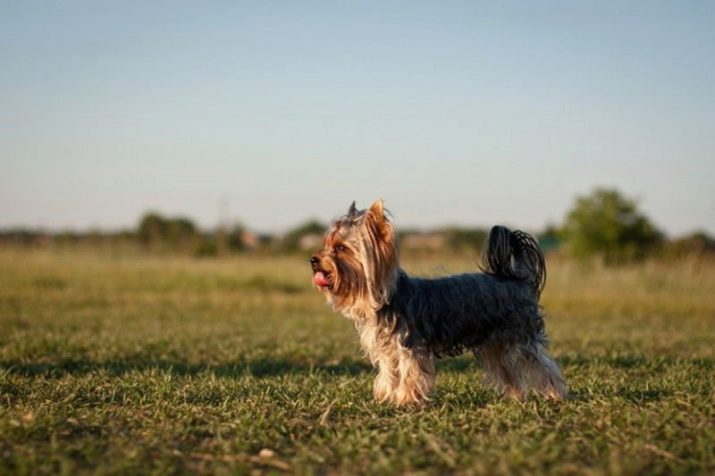
The Yorkshire Terrier is cute not only outside - he behaves as cute as he looks. The word "benevolent" will help to best describe his temper, because usually the Yorks do not seek to quarrel with the household, and if the house already has other animals that are not hostile towards the newcomer, then the dog will not provoke a conflict with them.
As for the relationship with someone outsider, then this feature is considered educated - they say, it all depends on the particular individual and what it was accustomed to. The cutest and kindest Yorkshirer, when meeting with a stranger, can suddenly show the skills of a guard dog and raise real fuss. Other individuals are fundamentally friendly to everyone and will make new acquaintances with both people and animals with pleasure.
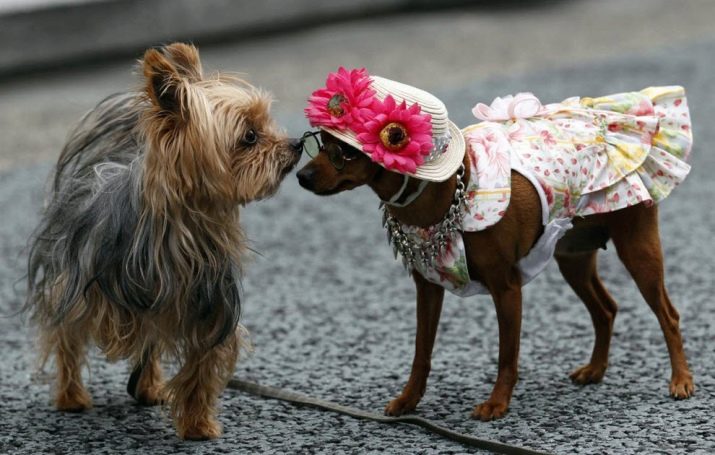
How old are dogs?
The development of a Yorkshire from birth to becoming a full-fledged adult is usually delayed by about a year, and experienced owners usually advise paying maximum attention to caring for the puppy during this period, since mistakes made at this stage can no longer be corrected. In this case, the development of the baby occurs unevenly. At one month of age, York seems to be disproportionately long and with its head too large, its paws look too short, and its ears hang unusually.
Its color is now predominantly black, but not eating out its eyes, there are golden spots and tan marks.
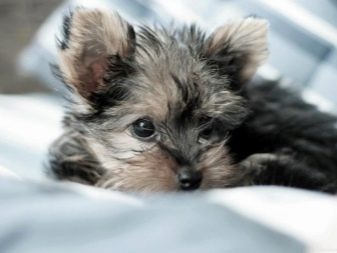
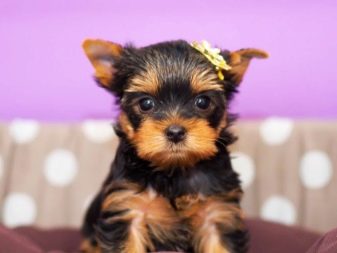
Only closer to 6 weeks of age, the little dog acquires a full set of milk teeth, and at 3 months there is another feature typical for an adult - the ears rise and finally take a standing position. By the age of 4 months, the chest is generally formed, but the puppy continues to grow - for another month his body will increase in length, and after 7 months there is an accelerated growth in height due to lengthening of the legs. By the same 7 months, the replacement of milk teeth with permanent teeth is also being completed - this stage the dog passes in about a month and a half.

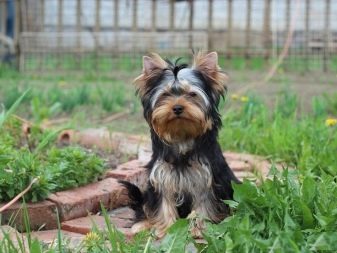
With teeth, the topic is separate - their growth must be carefully monitored. The fact is that the main teeth grow in Yorkshire either in front or behind the milk, but not in their place, and therefore, for a proper bite, you need to contact a veterinarian who will ensure their removal. The roots of the incisors are usually located quite deep in the thickness of the jaw, because these teeth never fall out themselves - if they were still not removed before the age of 8 months, you need to do this right now.
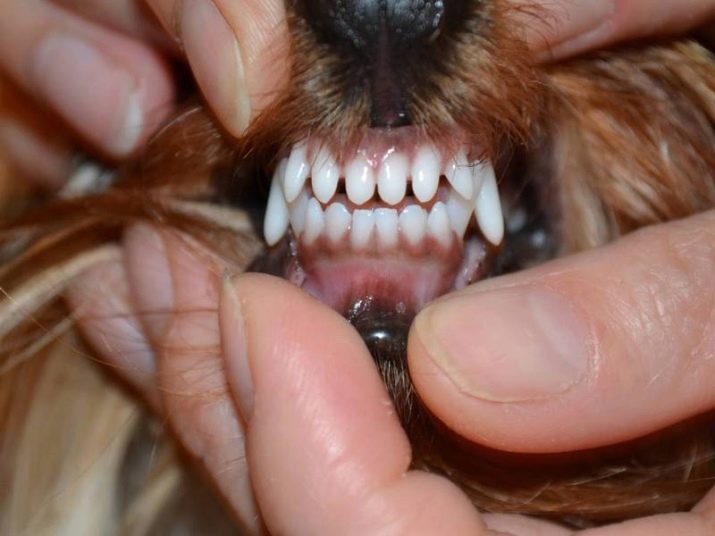
In the same 8 months, the Yorkshire Terrier acquires a color characteristic of an adult of its breed - the head becomes golden, and the body receives a steel tint. By the same moment, the puppy takes on the size of an adult dog, although much depends on individual characteristics. The weight is still less even, and although there is a table of how much a dog can weigh at one age or another, these are only indicative data. Do not worry if your pet is out of control. So, the average Yorkshire puppy weighs at different ages:
- 1 day - 110-125 grams;
- 1 month - 450-575 grams;
- 2 months - 825-890 grams;
- 3 months - 925-1200 grams;
- 4 months - 1.3-1.5 kilograms;
- 6 months - 1.5-2 kilograms;
- 8 months - 2.1-2.5 kilograms.
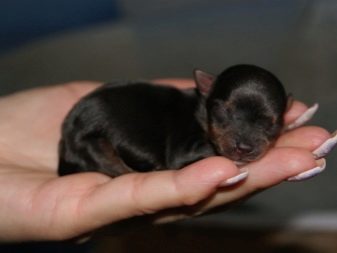
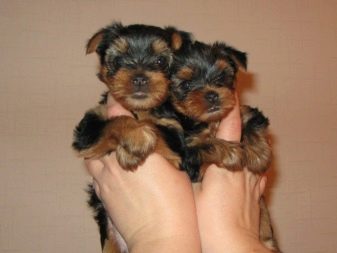
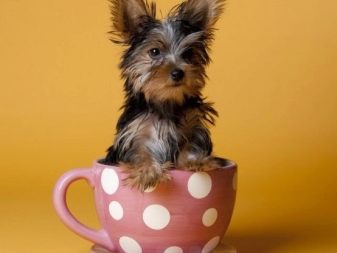
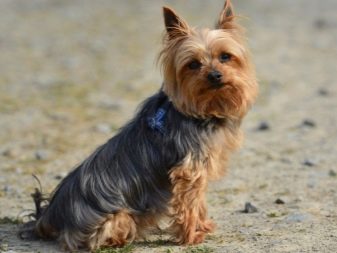
It is easy to see that the maximum growth rate is observed in the period from 2 to 4 months. By 8 months, the Yorkshire Terrier already looks like an adult dog, but further weight gain is still possible for several months.
Kinds
If you often and carefully watch Yorkshire terriers strolling along the street with their owners, you probably noticed that a strict description from the standard discussed above is not always followed so strictly. The claimed breed characteristics are very accurate, while babies are often born with certain violations of the standard. Moreover, many of them, even if by the properties of their appearance they cannot be admitted to the exhibition, still remain rare beauties, therefore they are dearly loved by people.
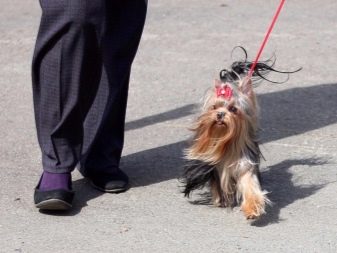
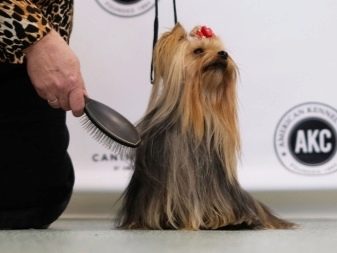
Varieties that are not too far removed from the standard, usually differ from it only in tonality of color. For example, that part of the dog, which must be tan according to requirements, is excessively lightened, or, on the contrary, acquires a dark chocolate color. Similar changes are possible in that part of the body that is covered with bluish-steel wool - here the cover can have a silver-gray or even completely black color.
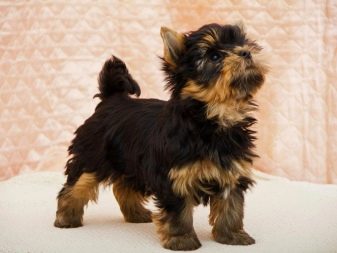

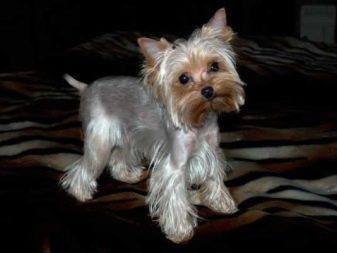
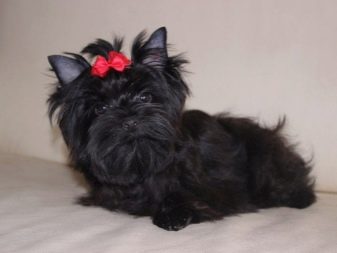
At the same time, experts have repeatedly noticed that wool color directly affects the features of its structure - apparently, this is due to the presence of an increased proportion of ancestral genes of a certain initial breed. So, the “right” Yorkshireer is different perfectly straight and smooth coat, but representatives of darker varieties cannot boast of such a thing - their cover is characterized by increased curliness, they are as if fluffy instead of having a smooth surface.
The excessively light color of the described fluffiness does not have, in terms of structure, it seems more correct, however, such wool has an extremely negative property to turn yellow over time.
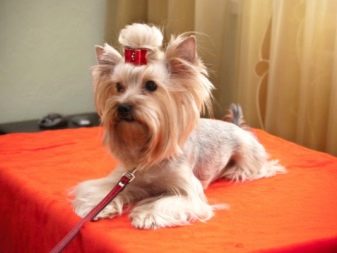
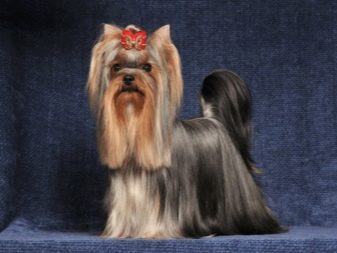
The shade of dark steel for wool on the dog’s body is considered to be a reference both in terms of color and in terms of the structure of the cover - it creates the most positive impression of the dog, but it is harder to get it all the rest. At the same time, recently, most breeders have focused on structure and silkiness, and not on shade, which is why on the streets you can see a variety of color varieties of the Yorkshire Terrier.
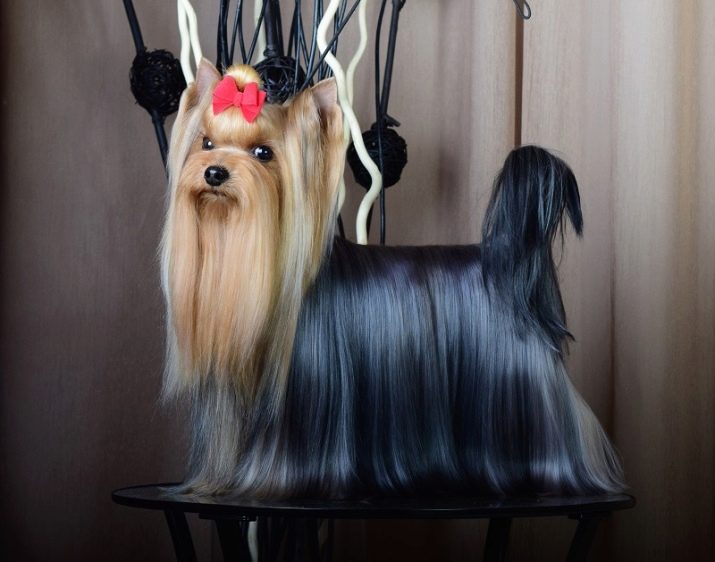
How to choose a puppy?
A real Yorkshireman is not cheap, so it is not surprising that the owner of such a dog wants to get a really purebred animal for his money, which can be taken to exhibitions and used for breeding. For this reason, the first advice experienced dog breeders give is never focus on photos in online ads, but always personally come to the nursery and see potential favorites in person.
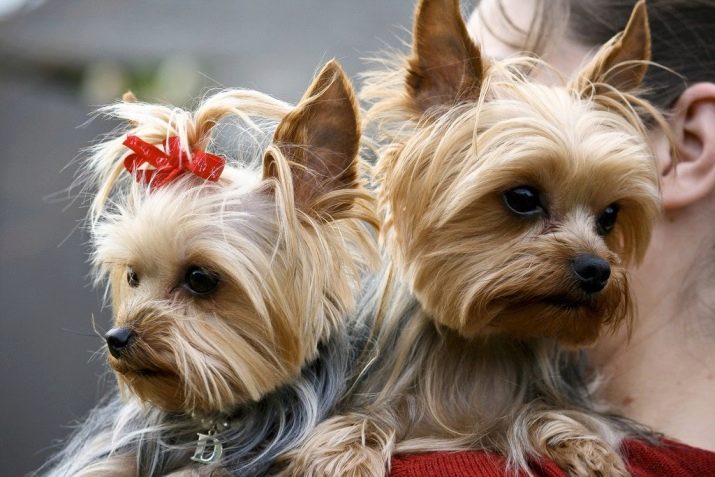
The likelihood of unpleasant surprises will be less if you know the breeder well as a responsible person, but a beginner who chooses a York for the first time is unlikely to have one. Again, do not believe the advice handed out on the Internet by strangers - ask for recommendations either from a friend's veterinarian, or from friends or acquaintances who have already purchased just such a doggie. Another place where you can find a worthy breeder is Exhibition, because there you can immediately draw conclusions about the work of such a person.
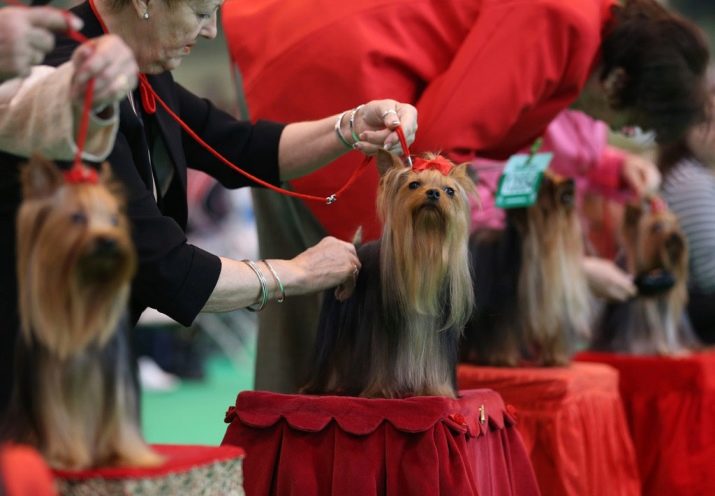
Choosing a puppy be sure to pay attention to the one who grew it. They do not become breeders under duress - a really good specialist will surely be “crazy” in his favorite pastime, he will be able to easily answer any of your questions about the breed, the peculiarities of caring for it, or any secrets. For such a specialist, all his kids - like their own children, in the process of communication, it becomes obvious that he loves them very much.
Whoever gets hit and wherever he won't give puppies will be interested in who gets and under what conditions.
If you see that you are a real enthusiast, then you can and should get four-legged ones from him.
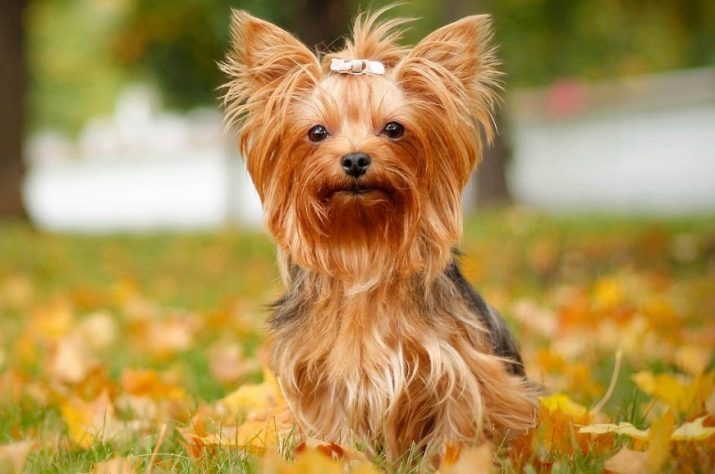
Babies are usually disassembled at the age of 2.5-3 months, but at this stage of their life path they differ very little from each other. For this reason, experienced people are advised to pay attention to mom - that at least should look attractive.
They pay attention to dad only in the second place, and often he is not there, so you have to be content with only photography. Both parents must have documents on the genealogy, in which at least 3 generations of ancestors were purebred Yorkshire. On the territory of Russia, similar documentation is issued by the Russian Cynological Federation.
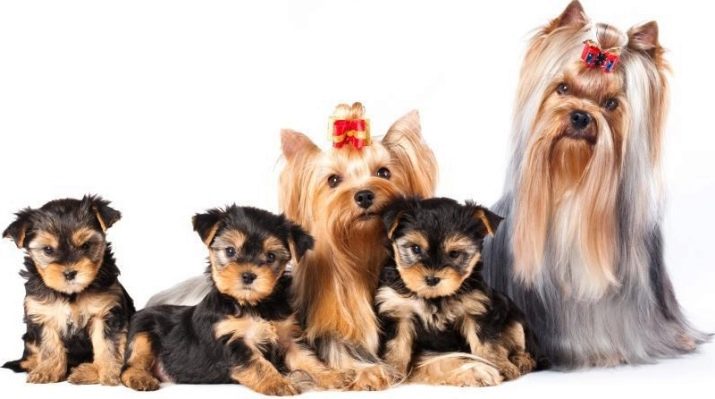
It's time to choose one puppy from the brood, so pay attention to each individual baby - you need an active and curious strong man who behaves the same as an adult dog - that is, he is curious and demonstrates aristocratic grace. The nose of a healthy baby is always black, moist and cool (the dog just woke up is warm), the gums are strictly saturated pink. Any swelling in the navel area may indicate health problems, so there should not be any.
As mentioned above, the coloring will be “childish,” that is, black with golden marks, therefore, wool should be evaluated only by its silkiness.
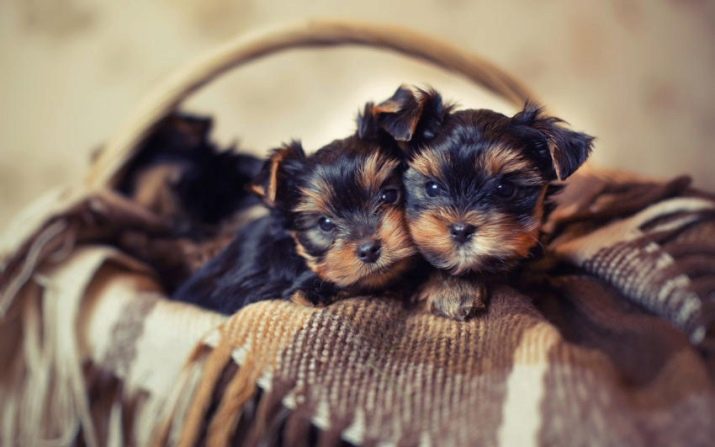
If everything is all right with the appearance of the dog and its documents, check whether the papers were really issued for this particular animal. This is determined by the stigma, which in Yorkers is usually located near the groin or on the inside of the ear.A code of letters and 6 digits allows the specialist to understand the place of birth and registration number of a particular individual - these numbers should be in all documents. By this time, the puppies should have already been given some vaccinations, so the baby should have its own veterinary passport with the notes on the mandatory procedures.
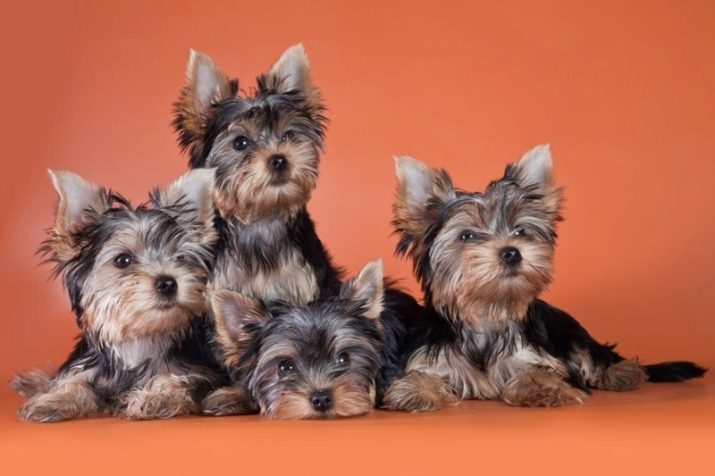
If you need not a simple Yorkshire, but a mini-York, be doubly careful - to purchase such doggies should only be from people whom authoritative people have recommended to you. Fraudsters in the guise of a miniature dog sell less healthy puppies or do not specifically feed ordinary Yorkshire terriers.

Conditions for maintenance and care
As soon as the baby gets into the house, immediately designate his zones for sleep and the toilet - the sooner he gets used to the established order, the better for the owners. In the future, changing the location of familiar infrastructure is undesirable - Yorkshire people get nervous from such disturbances. The novice should be settled in a warm corner of the room, for convenience it’s worth buying a special playpen or pet bed for your pet.
If you took the baby very early, the matter is not limited to one purchase - a two-month-old puppy needs to be vaccinated, because without this there can be no talk of walking along the street. At the same time, fresh air is useful for the baby - knowledgeable people advise daily take it out at least once for 10-15 minutes, provided that it is warm, but not very hot. The young doggie is not ready for long walks, however, their number should be gradually increased.
In an adult, the "norm" is 3 times a day for half an hour.
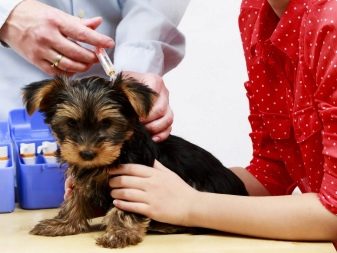
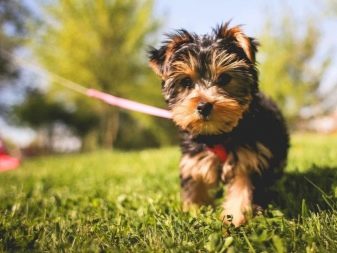
If the pet originally lives in a country house, then there he largely determines how much he will walk, the endurance of such a pet is slightly higher. At the same time, the owner still needs to monitor the situation - you must not let the animal overtax, so the beast that has played too much must be taken into the room, watered with water at a comfortable room temperature and carefully lured into the rest area so that the pet thinks that he himself so wanted.
Caring for a cute dog is quite complicated, and the pet itself is not always happy for him, but you cannot ignore this obligation. After bathing, you will have to cut your claws once every 2-3 weeks - at home you should stock up not only with good scissors, but also with silver nitrate or a special hemostatic pencil in case of a dog’s wound. If you are not sure what you can do, contact the grooming salon.
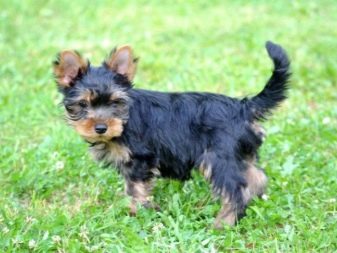
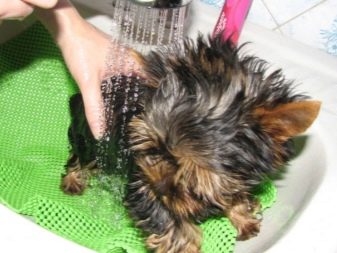
The corners of the pet’s eyes need to be cleaned twice a day with a damp cloth or cotton swab, the latter is also suitable for cleaning the ears. Crazy resistance can be caused by an attempt to brush your baby’s teeth, but you need to teach him to do this from an early age, otherwise at 3 years your teeth will begin to stagger, and by five they may fall out completely. Since Yorkies are distinguished by their long and beautiful coat, they need constant care.
Long-haired individuals will have to be washed quite often - literally every week, and even combed 2-3 times a day. Mowing greatly simplifies the task, because washing is required only once every 2-3 weeks, and you can comb your pet every other day.
These procedures are usually performed independently at home, but if they are followed by a haircut, you can order the entire complex in the salon. Clothing, by the way, helps protect the animal not only from the cold, but also partially from pollution.
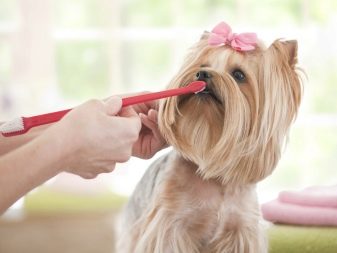
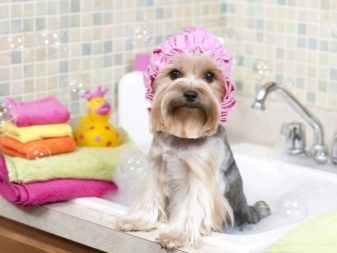
Bathing is a special task that requires compliance with certain rules. To begin with, the dog is carefully combed and only then planted in water at a temperature of 34-35 degrees. A rubber rug must be placed at the bottom of the dish, otherwise the dog will slip, get scared and will be set up against hygiene procedures. For washing, you should use dog shampoo - a human can provoke unforeseen consequences, some Yorkies fade from it.
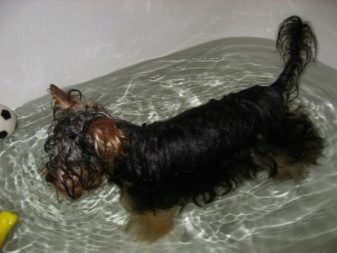
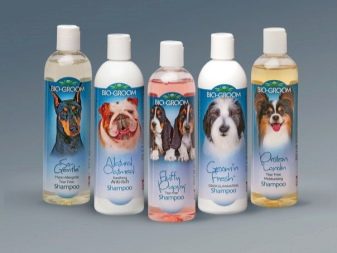
The bathed animal should be wrapped in a towel and taken to a warm room, and when the pet dries out a little, do combing. This is the best moment to cut hair where it is definitely not needed - on the pads of the paws and near the anus. You can immediately put your ears in shape, thanks to the correct curly trimming of the wool. If your dog has impressive hair, which you decide to constantly shorten on your own, comb the hair parting and trim it a little higher than the floor.
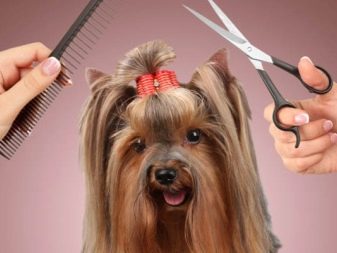

Feeding
Yorkshire terriers are good because they are more difficult to feed than representatives of many other dog breeds - this animal will not eat too much and will be able to stop in time. Like most other pets, the dog can be fed with specially produced feeds, as well as make a special menu of natural products. Everything is clear with feed - the higher their class, the better, especially if they are specially designed for small dog breeds. With a self-compiled menu is somewhat more complicated, because not every owner is able to balance it correctly.
The main product, as it should be a predator, is meat. Chicken and beef, cut into small pieces, are best suited for this role, so that the animal does not have to waste time and effort in cracking them. You don’t need to boil meat - you can give it raw, only follows pre scald food with boiling water to soften the fibers and kill bacteria. Instead of the actual meat, you can give offal, however, in which case it is better to give preference to dietary chicken or veal.
Garnish should give your favorite rice or buckwheat.
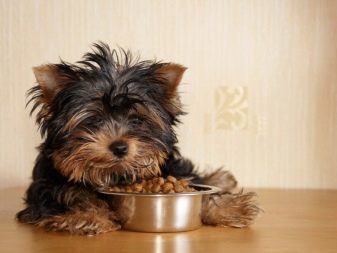

For dogs this is not very typical, however, Yorkshire Terriers love vegetables and fruits - for them it is a real treat, and not only in raw, but also in boiled form. It’s probably not worth using it, but giving regularly is simply necessary because they contain a large number of healthy vitamins and minerals. Representatives of this breed do not particularly favor fermented milk products, but it is also useful for their body. Experts advise to include in the diet cottage cheese, kefir and ryazhenka.
As often happens with thoroughbred dogs, many types of food that seem tasty and healthy for a person are completely unsuitable for feeding an animal.
The digestive system of the Yorkshire Terrier is fundamentally different from the human one, and therefore it is extremely undesirable for him to give fried, smoked and too fatty products, including with the same pork or sausage.

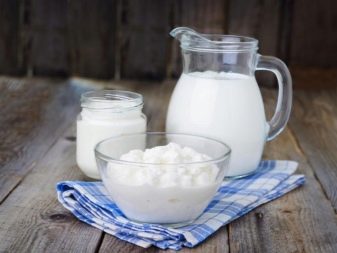
Many other products fall under the category of fatty too - both butter itself and many types of hard cheese. If yorkshirets digests buckwheat and rice normally, then oatmeal or semolina will not lead to anything good, the same applies to any baking. Despite the fact that the beast loves vegetables and fruits, it is contraindicated to give cabbage, citrus fruits, nuts and mushrooms. It is also not customary to feed the dog with sweets, first of all chocolate is unacceptable.
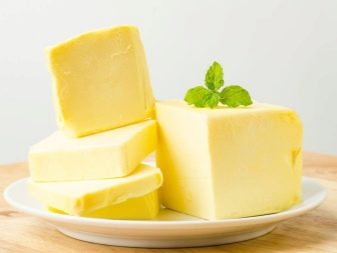
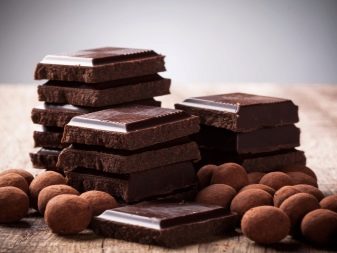
The appetite of the pet of this breed is a very inconsistent phenomenon, and it will definitely disappear if you suddenly decide to radically change the diet of the animal. If such a need arose, do it gradually, slightly replacing the usual ingredients with the unusual ones, increasing the dosage of new food step by step.
The normal diet for Yorkshire food is 2-3 times a day. If the dog is learning something, for success it must be encouraged in small portions of goodies, however, keep in mind that they must have a purely symbolic size, so as not to knock a tiny animal from a measured rhythm.
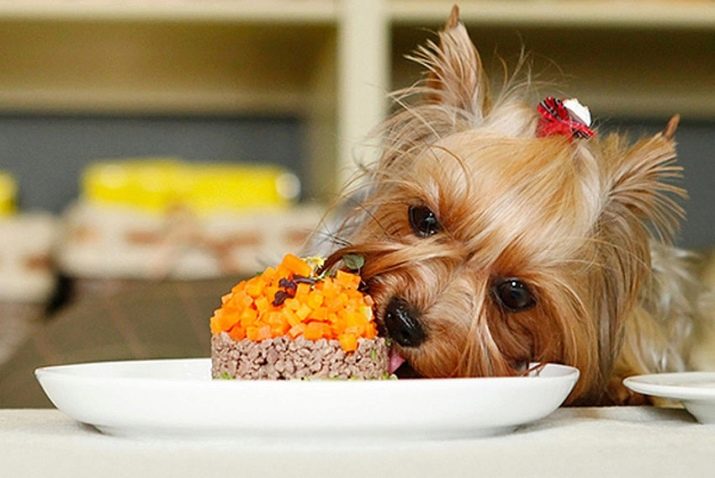
Parenting
Yorkshire is smarter than many other dog breeds, so training is usually not particularly difficult. If you start from an early age, the task will turn out to be extremely simple.The first thing you should prepare a dog for is the existence of various loud sounds. At first, you shouldn’t even speak too loudly or turn on the music “to the fullest” - let the dog get used to the existence of noisy people, technology and the metropolis gradually.

The same goes for too close contact with people. Although you want to immediately cuddle the baby and throw all his tenderness on him, doing this is not worth it. Let the pet learn the world around him gradually, and only when he is fully comfortable at home and gets used to all the households, start showing him the world around him. The correct order of training allows you to raise a self-confident dog that is not afraid of any challenges.
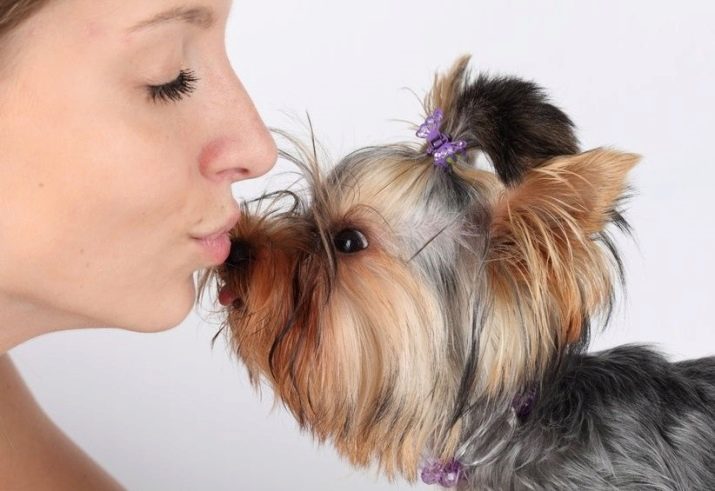
You can accustom an animal to the toilet at home in the same way as representatives of other breeds. The dog usually feels the urge soon after eating, the readiness to go to the toilet is expressed in a certain fussiness and slight nervousness, therefore, watch your pet, and as soon as it begins to show such activity, immediately grab it and carry it to where you equipped the tray. It is important to arrange it even before the puppy arrives - then the training will occur more quickly.
Do not forget that for the correctly completed work of the four-legged one must be praised for treating him with something tasty. To avoid unpleasant surprises in the early stages of training, you can dress the animal in a diaper, which, however, will have to be changed after each time, even if the baby correctly understood where his toilet is.

Despite the fact that the dog is smart and understands the commands well, the problem with his training lies in the pet's restraint - he is too active and cannot concentrate on training or any other task for too long. In order to quickly convey to the ward that you are happy with him, you must first determine the word or phrase, which is a universal expression of approval. The dog will quickly remember him and will understand that his actions are positive.
Do not get carried away very much - they can be frequent, but you need to be able to stop until the dog has lost interest in training, otherwise the cessation of classes at the behest of the pet may become a habit in the animal.
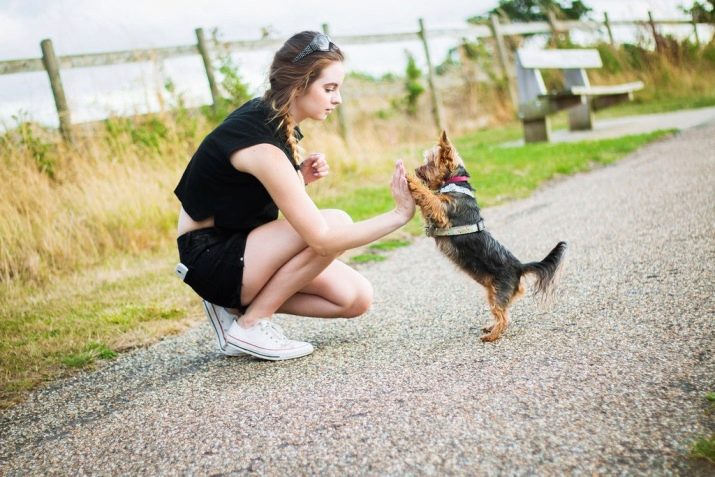
Yorkshire people are able to entertain themselves on their own - they easily come up with games for themselves, which is generally good. Another thing is that in their amusements they are often inclined to use objects and things that are completely not intended for this.
The owner's task is stop such creeps in time. Physical punishment is unacceptable - only the harsh tone and shout of "fu" is suitable, and even then only directly at the "moment of crime", and not ever later. For the Yorkshire Terrier, it will be very useful to get accustomed to a certain schedule, according to which he will eat, walk, swim and so on.
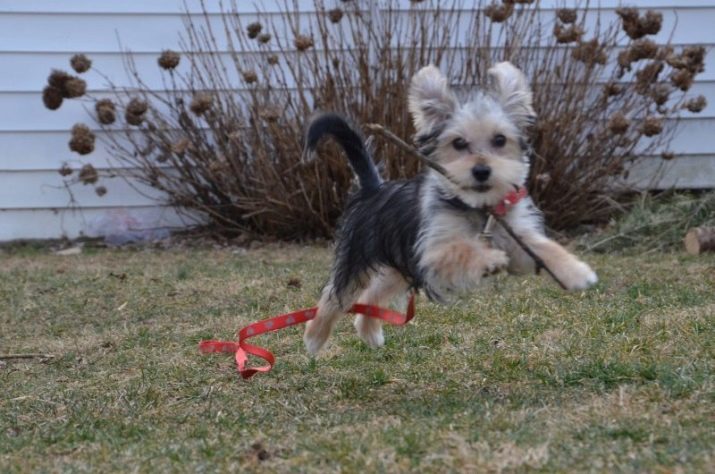
Owner reviews
Most owners characterize the Yorkshire Terrier as a true four-legged happiness - this is a very sweet and kind dog. If he is brought up correctly, there will be no problems with him - he will find a common language with households, and with other pets, and with guests, and with strangers. For him, neither a working vacuum cleaner nor the busy traffic of a large metropolis will become a problem. Such a companion is equally good for young people and for older people, because the aristocratic dog has a fairly calm disposition and usually does not cause unnecessary problems to the owner, and his independence is largely indicative and simulated.
Criticism of such doggies is relatively rare and comes mainly from those people who did not understand what was going on. The Yorkshireman is not a mongrel that does not require care at all, he will have to be carefully looked after, not only feeding and walking, but also bathing, cutting and training a pet.
Such an animal is like a child to be cared for and cherished.
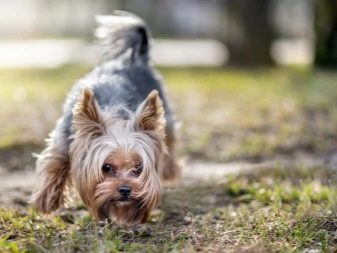
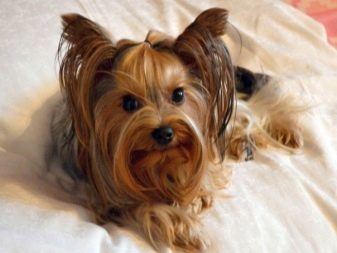
You will learn interesting facts about York in the next video.
